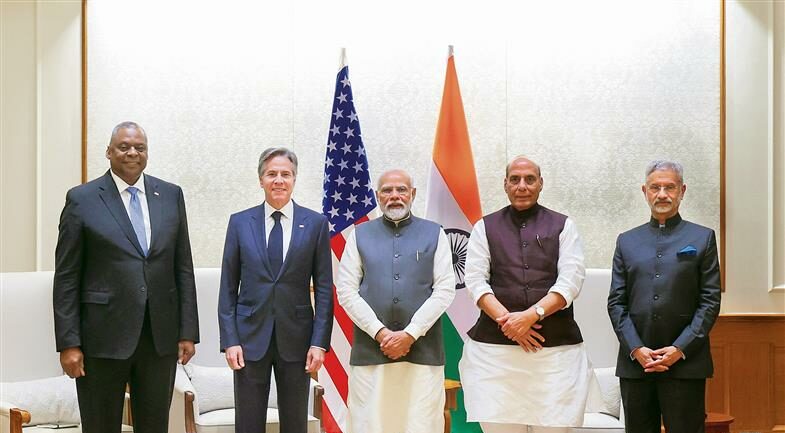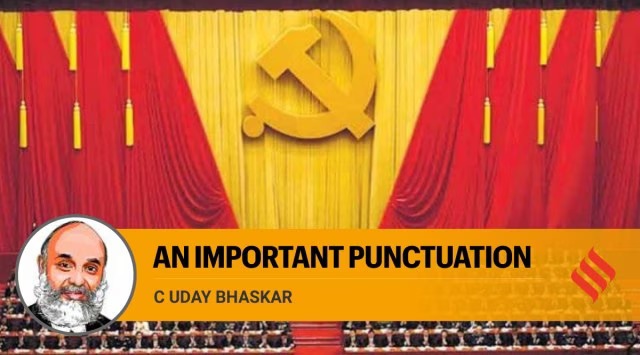Despite India-US 2+2, a Long and Solitary Haul
THE TRIBUNE
APLN member C. Uday Bhaskar argues that the outcome of the Biden-Xi meeting will have a significant bearing on major power relationships, with varying impact on Russia, the EU, Japan and India. Read the original article here.
The fifth India-US 2+2 ministerial dialogue, wherein the defence and foreign ministers of both nations meet annually, concluded on November 10 in New Delhi. The 2,300-word joint statement ticked all the relevant boxes on the bilateral agenda.
Defence Minister Rajnath Singh and External Affairs Minister S Jaishankar met their US counterparts, Secretary of Defence Lloyd J Austin III and Secretary of State Antony J Blinken, against the backdrop of the violence in Gaza. The previous dialogue was held in Washington in April 2022, weeks after the Russian invasion of Ukraine.
It is instructive that while both nations have taken different positions on the war in Ukraine, the resilience and depth of the relationship have allowed the political and security-related differences to be accommodated in a larger strategic correspondence. This has been reiterated in relation to the October 7 Hamas terror attack on Israel, where the Indian position is more oriented towards that of the US.
The US-India bilateral relationship, which moved from deep ‘estrangement’ over the prickly nuclear issue to one of tentative ‘engagement’ in late 2008 under the stewardship of then US President George W Bush and then PM Manmohan Singh, has become progressively more robust. The institution of the 2+2 dialogue at the defence-foreign minister level is testimony to the bilateral growth.
This relationship is not that of India becoming a US military ally. The US has 30 primary allies under the NATO banner. Instead, it is framed as a ‘partnership’, and it is evident that this relatively nascent strategic cooperation between the world’s oldest and largest democracies holds considerable potential relevance in the global context.
This aspect gains prominence in the run-up to the November 15 meeting in San Francisco between US President Joe Biden and his Chinese counterpart Xi Jinping on the sidelines of the APEC summit. The meeting aims to stabilise an increasingly fractious and discordant relationship. Taiwan is on top of the agenda that could exacerbate Washington-Beijing ties and this is one domain where escalation leading to war cannot be ruled out if emotive nationalism and domestic political compulsions trump prudence and geopolitical malleability. China remains a shared concern for the US and India and this was reflected in the remarks of Rajnath Singh at the 2+2, where he noted: “The India-US defence relationship has evolved into a strategic partnership characterised by mutual trust, shared values and a growing recognition of common interests in maintaining regional and global security. We increasingly find ourselves in agreement on strategic issues, including countering China’s aggression, promoting a free and open Indo-Pacific and addressing regional security challenges.”
The explicit reference to Chinese aggression by the Indian minister in a bilateral meeting with the US marks a progressive uptick in Delhi’s traditionally cautious approach, characterised by a ‘walking on eggshells’ engagement with Beijing. The reticence to name China was more discernible in the remarks of Austin, who said: “We have a common goal, a common view of the Indo-Pacific and that is that the Indo-Pacific should remain free and open. But our relationship is not just based on China, on the challenges that China presents. It’s based upon shared values.” The exact meaning of what is ‘shared’, however, is debatable.
The outcome of the Biden-Xi meeting will have a significant bearing on major power relationships, with varying impact on Russia, the EU, Japan and India. In the event that the US and China reach a modus vivendi on the Taiwan, trade and technology dissonance, India, for instance, would find itself operating within a different geopolitical framework to address its core security interests, as symbolised by the stalemate along the Line of Actual Control (LAC). A similar situation would apply to Japan and the Association of Southeast Asian Nations (ASEAN) involved with China in the South China Sea (SCS) dispute.
The Indian predicament over the territorial dispute with China had first erupted in 1962 and remains tangled ever since. A sullen stalemate continues to fester, with both sides locked in inflexible positions — rendered further intractable by nationalist narratives and domestic political rhetoric. In the post-Galwan clash (June 2020) period, India has forfeited certain patrolling rights and has to brace for a long vigil through the winter. The run-up to the 2024 General Election in India and Xi’s mounting challenges (marked by senior ministers and generals either disappearing from public life or being summarily dismissed, coupled with economic headwinds) do not bode well for the India-China bilateral relationship, which will remain fraught with latent tension and a huge trade imbalance in China’s favour.
For the younger generations, who may not recall India’s 1962 war against China — on November 21 that year, the People’s Liberation Army (under Chairman Mao Zedong), which had ‘taught India a lesson’ and routed the Indian Army in the Tawang region, declared a unilateral withdrawal. This happened even as a bewildered Indian Government, with PM Jawaharlal Nehru at the helm, had all but abandoned Assam.
It is evident that PM Modi does not want to emulate his illustrious predecessor in relation to China, hence the caution and reticence. Whether this approach is driven by electoral appeasement remains a matter of debate. Currently, neither India nor the US (or for that matter China) wants the current tension and competition to slide towards a military confrontation, either by accident or design.
For India, managing the China challenge along the contested LAC will be a case of Tagore’s ‘ekla chalo’ (walk alone). Shaping the dialogue with the US in a perspicacious manner may provide the stamina required for what will be a long and solitary haul.
Image: Bilateral: PM Modi with External Affairs Minister S Jaishankar, Defence Minister Rajnath Singh, US Secretary of State Antony Blinken (2nd from left) and Secretary of Defence Lloyd Austin (left). ANI




